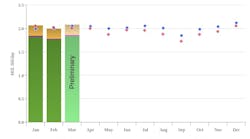By OGJ editors
HOUSTON, Sept. 5 -- A southern Alabama oil field with a unique trapping mechanism is still under development after having become the state's largest producing field in 2005.
Midroc Operating Co., private Dallas independent, has drilled more than 40 wells into the Little Cedar Creek field Jurassic Smackover limestone reservoir since becoming operator of the field in May 2000. Hunt Oil Co., Dallas, discovered the field in Conecuh County in 1994.
The field is located near the updip limit of the Smackover formation, and the trapping mechanism is interpreted as stratigraphic, the Alabama Oil & Gas Board reports. There is no faulting or structural closure based on current well control, and the Smackover displays monoclinal dip to the southwest at a rate of 200 ft/mile.
"This trapping mechanism is unique among Jurassic reservoirs throughout the entire Gulf Coast region," the board said.
The discovery well, Cedar Creek Land & Timber Co. 30-1, in 30-4n-12e, 10 miles southeast of Evergreen, Ala., went to a total depth of 12,100 ft. It flowed 108 b/d of oil and 49 Mcfd of gas on a 12/64-in. choke with 248 psi flowing tubing pressure from the Smackover.
Subsequent drilling by Midroc on 160-acre spacing has expanded the field limits to include more than 10,000 acres in 4n-12e and 4n-13e. Development continues mainly to the northeast.
Reservoir and unit
Little Cedar Creek field produced 1.17 million bbl of oil in 2005 and 1.64 million bbl in 2006, helping reverse the state's declining oil production trend, the board noted.
The Smackover pool "consists of two main porosity zones separated by a dense nonproductive zone." The pool is officially defined as Smackover strata between 11,490 ft and 11,580 ft in the Pugh 22-2 well in 22-4n-12e.
The western part of the field was unitized effective Jan. 1, 2005. The partial fieldwide unit covers more than 6,000 acres. Phase I of the two-phase allocation formula is based on 50% net hydrocarbon pore volume and 50% productivity. Phase II, which would begin when 5,622,557 bbl of oil have been produced, is based on 100% net hydrocarbon pore volume.
As new wells are drilled in the unit, the hydrocarbon pore volume and productivity of each new well are determined, and allocations for all unit tracts are recalculated or redetermined based on the new data.
